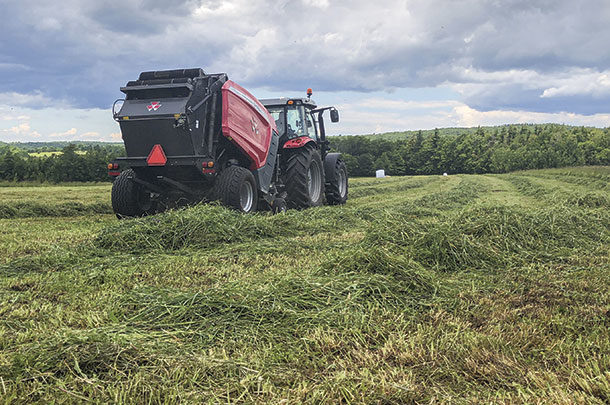Baled silage, or baleage, is a highly nutritious livestock feed and can help producers better manage their harvest window and harvest their crop at its optimum quality. Baleage is forage harvested at a higher moisture than dry hay, which is then wrapped in polyurethane plastic to eliminate oxygen so that anaerobic fermentation takes place. This phase converts available sugars to acids, preserving the forage and improving the nutritional value and palatability of the crop.
Silage bales beat dry hay
Silage bales have advantages over dry hay, but best management practices are in order.
First, bale silage at a higher moisture level than dry hay. This accomplishes two goals:
1. It gets forage off the field quickly at its optimal nutritional quality because it shortens the time needed for field curing after mowing and before baling. This is especially helpful during unpredictable or exceptionally wet weather.
2. It gives you more feed to work with. Forage baled as silage has less leaf and dry matter loss compared to forage that is harvested as dry hay, which undergoes more mechanical harvesting processes to ensure drydown.
Take the steps needed to ensure your baled silage will be of higher quality than dry hay. The optimal moisture for baling forage as silage ranges between 45% and 60%. Baling forage at this higher moisture helps preserve dry matter yield because every day of delay after mowing and before baling can result in a 5% to 6% yield loss, depending on weather conditions. We all know getting hay dried down to an ideal moisture for dry hay can be tough when the weather is off.
This shorter harvest process can provide a nutritional edge for your livestock. It lets you harvest at a more ideal stage of maturity than if you were simply “making hay while the sun shines.” This is important because as forages mature, the quality generally declines (Figure 1).

Younger, more vegetative forages have greater nutritive content and better meet the needs of a broader range of ruminants, such as growing and lactating animals.
Nutritive value of baled silage
A University of Florida study compared Tifton 85 bermudagrass dry hay and baleage and found the baleage had greater nutritive value overall (Table 1).

Relative forage quality (RFQ) was more than 42 points greater in baled silage than dry hay. Dry matter intake (DMI) wa 0.5% greater, crude protein (CP) was more than 2% greater and total digestible nutrients (TDN) was nearly 15% more in silage bales compared to dry hay.
Conclusions from this study indicate the baleage analyzed provided:
- Greater overall forage quality
- The ability to feed baleage to dry beef cows during gestation without supplementation
- The ability to feed it to mature bulls and meet their nutritional requirements without supplementation
On the other hand, if you fed dry hay from this study to any class of livestock, you would need additional supplementation to meet their nutritional requirements.
There are forage species, such as cool-season grasses and legumes, that have greater nutritive value than bermudagrass and can be harvested and stored as baled silage. Their resulting increase in digestibility, CP, DMI and RFQ makes baled silage suitable for a wide range of ruminant livestock. The increase in feeding value combined with the ability to harvest the forage at a more ideal stage of growth means the low-quality, stemmy first-cutting hay that previously only met the needs of your low-input mature stock can now be high-quality, highly palatable forage that provides the nutrition needed for your young, growing animals or those in peak lactation.
Plus, your livestock will eat more of the forage you have invested in growing and harvesting and leave less lying on the ground. Baleage has as much as 10% to 30% less refusal than dry hay, depending on forage species and growth stage at which the dry hay was harvested.
As the next hay season draws near, now is the time to review nutrition needs for your livestock and consider effective ways of delivering the most palatable and nutritious forage possible. Baled silage has earned its right to be part of these considerations.












